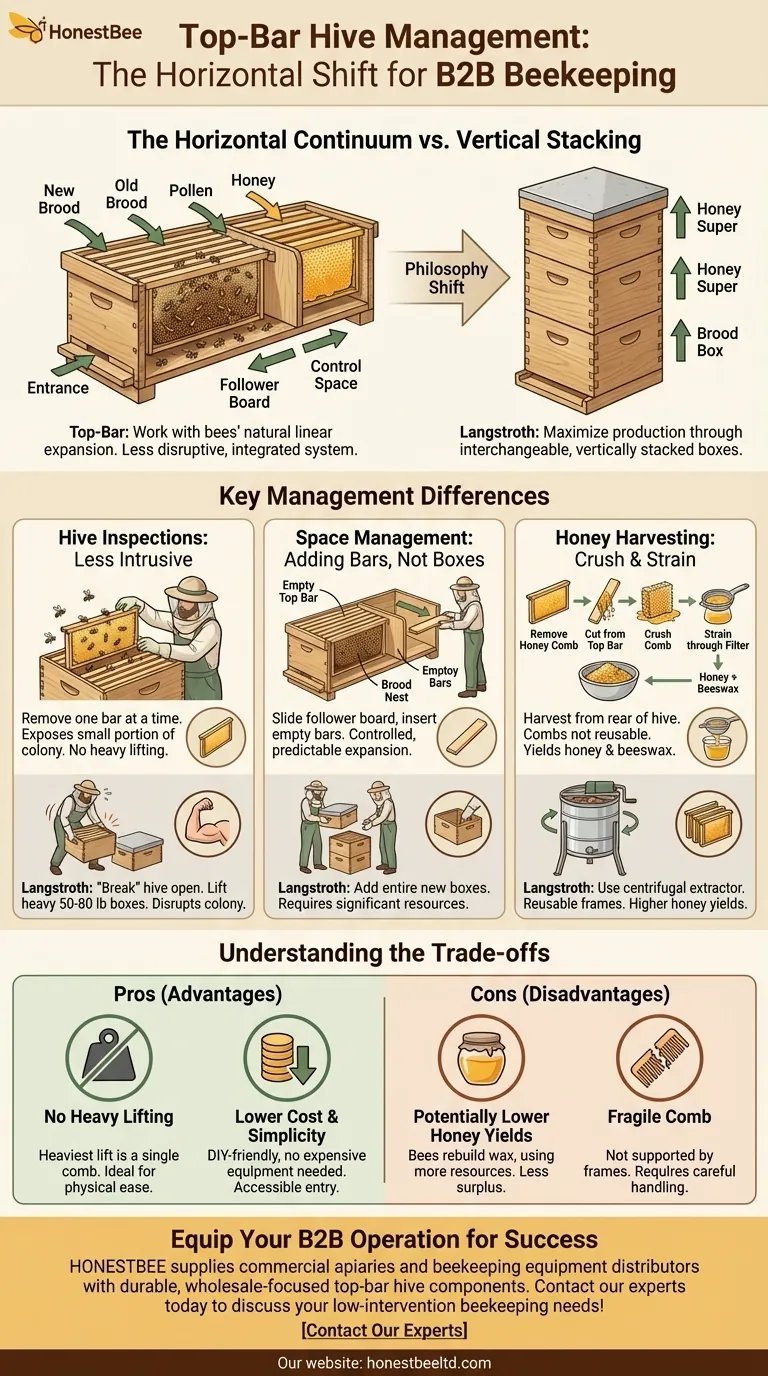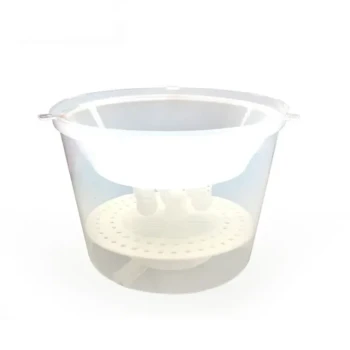In short, hive management is different in top-bar hives because they are managed horizontally, not vertically. Instead of stacking boxes, you manage a single, long hive body by adding empty bars for expansion, using a movable "follower board" to control the colony's space, and harvesting honey from the rear of the hive. This creates a fundamentally less intrusive and physically less demanding system.
The core difference is a shift in philosophy. Traditional Langstroth hive management is about maximizing production through interchangeable, vertically stacked boxes. Top-bar hive management is about working with the bees' natural linear expansion in a less disruptive, integrated system.
The Horizontal Philosophy: From Stacks to a Continuum
In a standard Langstroth hive, bees are encouraged to expand upwards into new boxes (supers). A top-bar hive changes this dynamic entirely, working on a horizontal plane that more closely mimics a bee colony in a hollow log.
How Bees Use the Space
The queen establishes her brood nest near the entrance. As the colony grows, she continues laying in new comb built adjacent to the existing brood nest.
This pushes the storage of pollen and honey further down the hive, away from the entrance. This creates a linear progression: entrance, new brood, old brood, pollen, and finally honey at the very back.
The Role of the Follower Board
A follower board is a solid partition, shaped like the hive's cross-section, that acts as a movable wall.
This is the beekeeper's primary tool for space management. You can shrink the hive's internal volume for a small colony or for winter, and expand it as the colony grows, ensuring the bees always have the right amount of space to efficiently manage and defend.
Key Management Differences in Practice
The horizontal design dictates every aspect of your interaction with the hive.
Hive Inspections: Less Intrusive
Inspections in a top-bar hive are far less disruptive. You only remove one bar at a time, exposing a very small portion of the colony.
This contrasts sharply with a Langstroth hive, where you must "break" the hive open and often lift heavy, 50-80 lb boxes, disrupting the entire colony.
Space Management: Adding Bars, Not Boxes
When the colony needs more room, you do not add a box. Instead, you slide the follower board back and insert new, empty top bars at the edge of the brood nest.
This encourages the bees to build fresh comb exactly where they need it, allowing for controlled, predictable expansion.
Honey Harvesting: Crush and Strain
Honey is harvested by removing the honey-filled combs from the very back of the hive—the oldest combs. Because these combs are not in frames, they cannot be put in a centrifugal extractor.
The standard method is crush and strain: the comb is cut from the top bar, crushed, and the honey is strained through a filter. This process yields both honey and beeswax, but requires the bees to rebuild the comb from scratch.
Understanding the Trade-offs
The top-bar system is not inherently better or worse, but it involves a distinct set of advantages and disadvantages.
Pro: No Heavy Lifting
The single biggest advantage for many beekeepers is the elimination of heavy lifting. The heaviest thing you will ever lift is a single comb full of honey, which weighs only a few pounds.
Pro: Lower Cost and Simplicity
Top-bar hives can be easily built from scrap wood, and the only internal components are simple wooden bars. You do not need to buy frames, foundation, or an expensive honey extractor, making it a very accessible entry point into beekeeping.
Con: Potentially Lower Honey Yields
The crush-and-strain method means the bees must expend significant energy and resources (honey) to constantly rebuild wax comb. In a Langstroth system, extracted combs are returned to the hive, saving the bees this work and often resulting in higher honey yields.
Con: Fragile Comb
Since the comb is not supported by a four-sided frame, it is more fragile and must be handled carefully. If you turn a top-bar comb sideways, it can easily break off the bar. This requires a slow, deliberate inspection technique.
Making the Right Choice for Your Goals
Your beekeeping goals should determine which hive style you choose. The management practices are a direct reflection of the system's core design.
- If your primary focus is a natural, low-intervention approach with no heavy lifting: A top-bar hive is an excellent choice that aligns perfectly with these priorities.
- If your primary focus is maximizing honey production and efficiency: The Langstroth hive's re-usable frames and expandability make it the conventional choice for production.
- If your primary focus is low initial cost and a DIY-friendly project: The top-bar hive is one of the most affordable and simplest ways to get started in beekeeping.
Ultimately, choosing a top-bar hive means embracing a management style that prioritizes a less disruptive partnership with your bees.

Summary Table:
| Aspect | Top-Bar Hive | Langstroth Hive |
|---|---|---|
| Expansion | Add bars horizontally | Stack boxes vertically |
| Key Tool | Movable follower board | Additional supers/boxes |
| Harvesting | Crush and strain method | Extractor with reusable frames |
| Physical Demand | Minimal (no heavy lifting) | High (lift 50-80 lb boxes) |
| Comb | Fragile, built from scratch | Supported by frames, often with foundation |
Ready to adopt a simpler, more natural approach to beekeeping? HONESTBEE supplies commercial apiaries and beekeeping equipment distributors with the durable, wholesale-focused top-bar hive components needed for low-intervention hive management. Let us help you equip your operation for success. Contact our experts today to discuss your needs!
Visual Guide

Related Products
- Top Bar Beehive for Beekeeping Wholesales Kenya Top Bar Hive
- Long Langstroth Style Horizontal Top Bar Hive for Wholesale
- HONESTBEE Advanced Ergonomic Stainless Steel Hive Tool for Beekeeping
- Professional Dual-End Stainless Steel Hive Tool for Beekeeping
- Professional Galvanized Hive Strap with Secure Locking Buckle for Beekeeping
People Also Ask
- What are the advantages of harvesting honey from a top bar hive? Low-Cost, Simple Harvesting for Beekeepers
- Which is better Kenya top bar hive or Langstroth? Choose the Right Hive for Your Goals
- What are the labor requirements for a KTBH vs. Langstroth hive? A Guide for Apiary Efficiency
- How should a beekeeper prepare a top-bar hive for overwintering? A Guide to Ensure Colony Survival
- What are the benefits of extra wax production in top bar hives? A Natural Byproduct for Craft & Efficiency



















